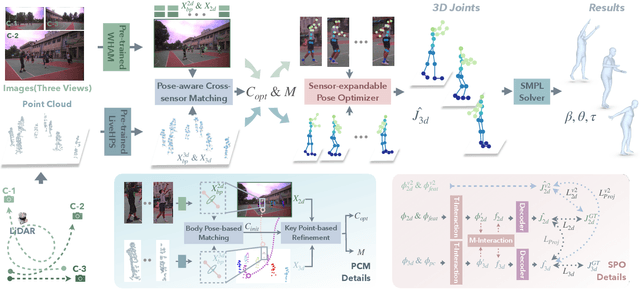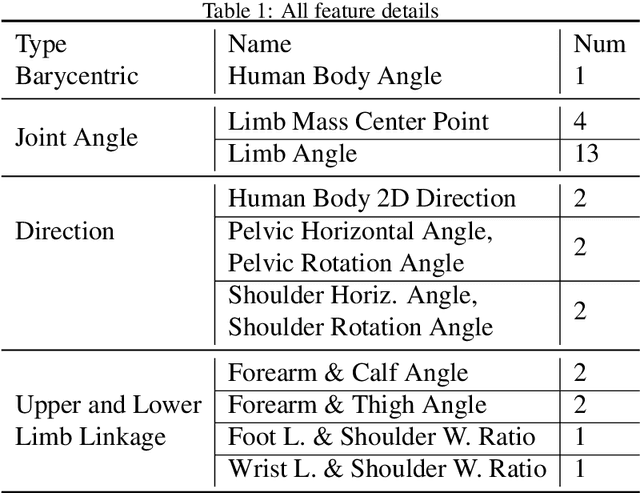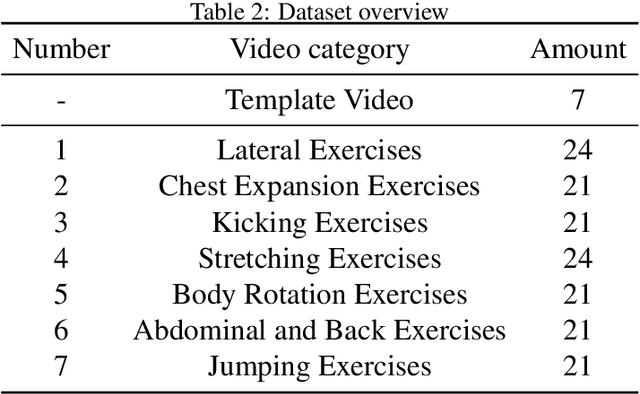3d Human Pose Estimation
3D Human Pose Estimation is a computer vision task that involves estimating the 3D positions and orientations of body joints and bones from 2D images or videos. The goal is to reconstruct the 3D pose of a person in real time, which can be used in a variety of applications, such as virtual reality, human-computer interaction, and motion analysis.
Papers and Code
ActionPose: Pretraining 3D Human Pose Estimation with the Dark Knowledge of Action
Aug 31, 2024



2D-to-3D human pose lifting is an ill-posed problem due to depth ambiguity and occlusion. Existing methods relying on spatial and temporal consistency alone are insufficient to resolve these problems because they lack semantic information of the motions. To overcome this, we propose ActionPose, a framework that leverages action knowledge by aligning motion embeddings with text embeddings of fine-grained action labels. ActionPose operates in two stages: pretraining and fine-tuning. In the pretraining stage, the model learns to recognize actions and reconstruct 3D poses from masked and noisy 2D poses. During the fine-tuning stage, the model is further refined using real-world 3D human pose estimation datasets without action labels. Additionally, our framework incorporates masked body parts and masked time windows in motion modeling to mitigate the effects of ambiguous boundaries between actions in both temporal and spatial domains. Experiments demonstrate the effectiveness of ActionPose, achieving state-of-the-art performance in 3D pose estimation on public datasets, including Human3.6M and MPI-INF-3DHP. Specifically, ActionPose achieves an MPJPE of 36.7mm on Human3.6M with detected 2D poses as input and 15.5mm on MPI-INF-3DHP with ground-truth 2D poses as input.
FreeCap: Hybrid Calibration-Free Motion Capture in Open Environments
Nov 07, 2024



We propose a novel hybrid calibration-free method FreeCap to accurately capture global multi-person motions in open environments. Our system combines a single LiDAR with expandable moving cameras, allowing for flexible and precise motion estimation in a unified world coordinate. In particular, We introduce a local-to-global pose-aware cross-sensor human-matching module that predicts the alignment among each sensor, even in the absence of calibration. Additionally, our coarse-to-fine sensor-expandable pose optimizer further optimizes the 3D human key points and the alignments, it is also capable of incorporating additional cameras to enhance accuracy. Extensive experiments on Human-M3 and FreeMotion datasets demonstrate that our method significantly outperforms state-of-the-art single-modal methods, offering an expandable and efficient solution for multi-person motion capture across various applications.
Marker-free Human Gait Analysis using a Smart Edge Sensor System
Nov 14, 2024The human gait is a complex interplay between the neuronal and the muscular systems, reflecting an individual's neurological and physiological condition. This makes gait analysis a valuable tool for biomechanics and medical experts. Traditional observational gait analysis is cost-effective but lacks reliability and accuracy, while instrumented gait analysis, particularly using marker-based optical systems, provides accurate data but is expensive and time-consuming. In this paper, we introduce a novel markerless approach for gait analysis using a multi-camera setup with smart edge sensors to estimate 3D body poses without fiducial markers. We propose a Siamese embedding network with triplet loss calculation to identify individuals by their gait pattern. This network effectively maps gait sequences to an embedding space that enables clustering sequences from the same individual or activity closely together while separating those of different ones. Our results demonstrate the potential of the proposed system for efficient automated gait analysis in diverse real-world environments, facilitating a wide range of applications.
Crowd3D++: Robust Monocular Crowd Reconstruction with Upright Space
Nov 09, 2024This paper aims to reconstruct hundreds of people's 3D poses, shapes, and locations from a single image with unknown camera parameters. Due to the small and highly varying 2D human scales, depth ambiguity, and perspective distortion, no existing methods can achieve globally consistent reconstruction and accurate reprojection. To address these challenges, we first propose Crowd3D, which leverages a new concept, Human-scene Virtual Interaction Point (HVIP), to convert the complex 3D human localization into 2D-pixel localization with robust camera and ground estimation to achieve globally consistent reconstruction. To achieve stable generalization on different camera FoVs without test-time optimization, we propose an extended version, Crowd3D++, which eliminates the influence of camera parameters and the cropping operation by the proposed canonical upright space and ground-aware normalization transform. In the defined upright space, Crowd3D++ also designs an HVIPNet to regress 2D HVIP and infer the depths. Besides, we contribute two benchmark datasets, LargeCrowd and SyntheticCrowd, for evaluating crowd reconstruction in large scenes. The source code and data will be made publicly available after acceptance.
GLOVER: Generalizable Open-Vocabulary Affordance Reasoning for Task-Oriented Grasping
Nov 19, 2024Inferring affordable (i.e., graspable) parts of arbitrary objects based on human specifications is essential for robots advancing toward open-vocabulary manipulation. Current grasp planners, however, are hindered by limited vision-language comprehension and time-consuming 3D radiance modeling, restricting real-time, open-vocabulary interactions with objects. To address these limitations, we propose GLOVER, a unified Generalizable Open-Vocabulary Affordance Reasoning framework, which fine-tunes the Large Language Models (LLMs) to predict visual affordance of graspable object parts within RGB feature space. We compile a dataset of over 10,000 images from human-object interactions, annotated with unified visual and linguistic affordance labels, to enable multi-modal fine-tuning. GLOVER inherits world knowledge and common-sense reasoning from LLMs, facilitating more fine-grained object understanding and sophisticated tool-use reasoning. To enable effective real-world deployment, we present Affordance-Aware Grasping Estimation (AGE), a non-parametric grasp planner that aligns the gripper pose with a superquadric surface derived from affordance data. In evaluations across 30 real-world scenes, GLOVER achieves success rates of 86.0% in part identification and 76.3% in grasping, with speeds approximately 330 times faster in affordance reasoning and 40 times faster in grasping pose estimation than the previous state-of-the-art.
RopeTP: Global Human Motion Recovery via Integrating Robust Pose Estimation with Diffusion Trajectory Prior
Oct 27, 2024We present RopeTP, a novel framework that combines Robust pose estimation with a diffusion Trajectory Prior to reconstruct global human motion from videos. At the heart of RopeTP is a hierarchical attention mechanism that significantly improves context awareness, which is essential for accurately inferring the posture of occluded body parts. This is achieved by exploiting the relationships with visible anatomical structures, enhancing the accuracy of local pose estimations. The improved robustness of these local estimations allows for the reconstruction of precise and stable global trajectories. Additionally, RopeTP incorporates a diffusion trajectory model that predicts realistic human motion from local pose sequences. This model ensures that the generated trajectories are not only consistent with observed local actions but also unfold naturally over time, thereby improving the realism and stability of 3D human motion reconstruction. Extensive experimental validation shows that RopeTP surpasses current methods on two benchmark datasets, particularly excelling in scenarios with occlusions. It also outperforms methods that rely on SLAM for initial camera estimates and extensive optimization, delivering more accurate and realistic trajectories.
MPL: Lifting 3D Human Pose from Multi-view 2D Poses
Aug 20, 2024Estimating 3D human poses from 2D images is challenging due to occlusions and projective acquisition. Learning-based approaches have been largely studied to address this challenge, both in single and multi-view setups. These solutions however fail to generalize to real-world cases due to the lack of (multi-view) 'in-the-wild' images paired with 3D poses for training. For this reason, we propose combining 2D pose estimation, for which large and rich training datasets exist, and 2D-to-3D pose lifting, using a transformer-based network that can be trained from synthetic 2D-3D pose pairs. Our experiments demonstrate decreases up to 45% in MPJPE errors compared to the 3D pose obtained by triangulating the 2D poses. The framework's source code is available at https://github.com/aghasemzadeh/OpenMPL .
UniHOI: Learning Fast, Dense and Generalizable 4D Reconstruction for Egocentric Hand Object Interaction Videos
Nov 14, 2024Egocentric Hand Object Interaction (HOI) videos provide valuable insights into human interactions with the physical world, attracting growing interest from the computer vision and robotics communities. A key task in fully understanding the geometry and dynamics of HOI scenes is dense pointclouds sequence reconstruction. However, the inherent motion of both hands and the camera makes this challenging. Current methods often rely on time-consuming test-time optimization, making them impractical for reconstructing internet-scale videos. To address this, we introduce UniHOI, a model that unifies the estimation of all variables necessary for dense 4D reconstruction, including camera intrinsic, camera poses, and video depth, for egocentric HOI scene in a fast feed-forward manner. We end-to-end optimize all these variables to improve their consistency in 3D space. Furthermore, our model could be trained solely on large-scale monocular video dataset, overcoming the limitation of scarce labeled HOI data. We evaluate UniHOI with both in-domain and zero-shot generalization setting, surpassing all baselines in pointclouds sequence reconstruction and long-term 3D scene flow recovery. UniHOI is the first approach to offer fast, dense, and generalizable monocular egocentric HOI scene reconstruction in the presence of motion. Code and trained model will be released in the future.
SCRREAM : SCan, Register, REnder And Map:A Framework for Annotating Accurate and Dense 3D Indoor Scenes with a Benchmark
Oct 30, 2024



Traditionally, 3d indoor datasets have generally prioritized scale over ground-truth accuracy in order to obtain improved generalization. However, using these datasets to evaluate dense geometry tasks, such as depth rendering, can be problematic as the meshes of the dataset are often incomplete and may produce wrong ground truth to evaluate the details. In this paper, we propose SCRREAM, a dataset annotation framework that allows annotation of fully dense meshes of objects in the scene and registers camera poses on the real image sequence, which can produce accurate ground truth for both sparse 3D as well as dense 3D tasks. We show the details of the dataset annotation pipeline and showcase four possible variants of datasets that can be obtained from our framework with example scenes, such as indoor reconstruction and SLAM, scene editing & object removal, human reconstruction and 6d pose estimation. Recent pipelines for indoor reconstruction and SLAM serve as new benchmarks. In contrast to previous indoor dataset, our design allows to evaluate dense geometry tasks on eleven sample scenes against accurately rendered ground truth depth maps.
Unlabeled Action Quality Assessment Based on Multi-dimensional Adaptive Constrained Dynamic Time Warping
Oct 18, 2024



The growing popularity of online sports and exercise necessitates effective methods for evaluating the quality of online exercise executions. Previous action quality assessment methods, which relied on labeled scores from motion videos, exhibited slightly lower accuracy and discriminability. This limitation hindered their rapid application to newly added exercises. To address this problem, this paper presents an unlabeled Multi-Dimensional Exercise Distance Adaptive Constrained Dynamic Time Warping (MED-ACDTW) method for action quality assessment. Our approach uses an athletic version of DTW to compare features from template and test videos, eliminating the need for score labels during training. The result shows that utilizing both 2D and 3D spatial dimensions, along with multiple human body features, improves the accuracy by 2-3% compared to using either 2D or 3D pose estimation alone. Additionally, employing MED for score calculation enhances the precision of frame distance matching, which significantly boosts overall discriminability. The adaptive constraint scheme enhances the discriminability of action quality assessment by approximately 30%. Furthermore, to address the absence of a standardized perspective in sports class evaluations, we introduce a new dataset called BGym.
 Add to Chrome
Add to Chrome Add to Firefox
Add to Firefox Add to Edge
Add to Edge